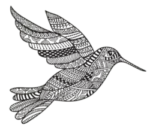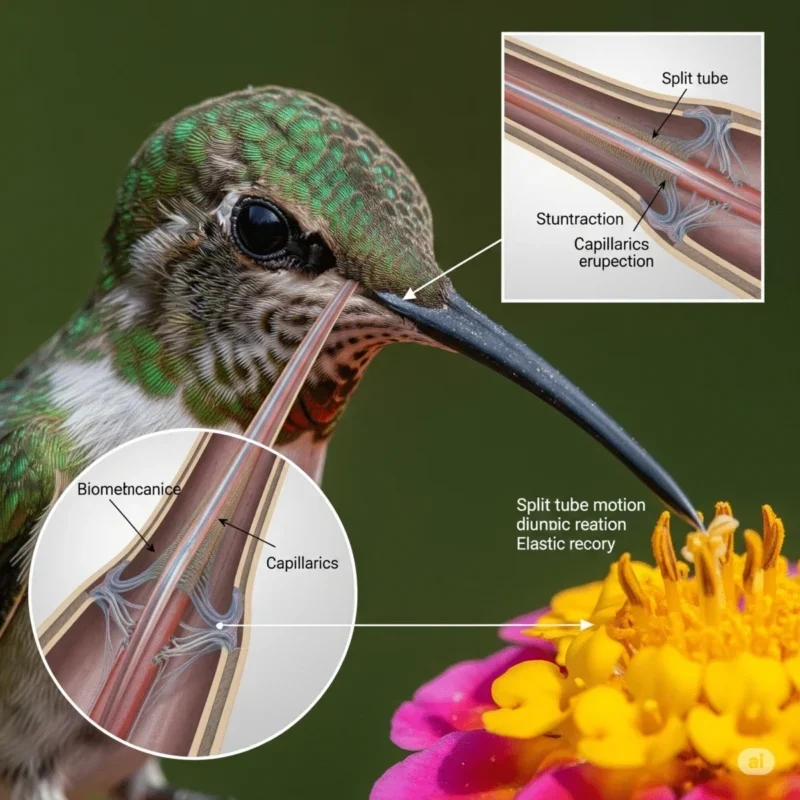The hummingbird, zipping through gardens like a caffeinated fairy, captures attention with its charm and agility. But there’s more to admire – the incredible tongue of this tiny marvel.
Why the Fuss About a Tongue?
Imagine a tongue that can:
- Extend twice the length of your face.
- Move faster than the eye can follow.
- Efficiently pump liquid better than any machine.
It’s a tongue that makes our ice cream-licking abilities look trivial.
Anatomy 101: Not Your Average Licker
Hummingbird tongues are marvels of evolution:
- Length: So long they coil around the skull when retracted.
- Grooves: Two nectar-catching channels for double efficiency.
- Forked Tip: Splits into two flattened ends for ultimate nectar capture.
The Great Nectar Heist
These tiny avian speedsters lap nectar up to 20 times per second. Their tongue is a high-speed trap, grabbing nectar faster than the human eye can blink.
Evolution’s MasterpieceThe hummingbird tongue didn’t develop overnight.
- Evolved over millions of years.
- A product of coevolution with flowers, refining their nectar-sipping skills.
Debunking the Myths
- Not Straws: Hummingbirds don’t sip like humans.
- Beyond Capillary Action: The outdated “straw theory” doesn’t conform to modern science.
The Real Deal: Elastic Micropump Theory
Hummingbird tongues function like spring-loaded pumps:
- Compress inside the bill, storing energy.
- Rapidly flick in and out of flowers to collect nectar.
High-Tech Tongues Made of Keratin
- It is composed of the same protein as fingernails.
- Flexible and agile, performing acrobatics inside flowers with ease.
A Day in the Life of a Humm ingbird Tongue
- Morning: Nectar breakfast.
- Midday: Acrobatics in flowers, precision sipping.
- Evening: Rest, dreaming of tomorrow’s floral feasts.
Hummingbird Tongues vs. The World
- Birds: No competition: this little beauty dominates.
- Mammals: Even legendary tongues like Gene Simmons’ are outclassed.
The Science of Sipping
High-speed cameras reveal:
- A stunning display of biomechanics.
- Where fluid dynamics meets biology in perfect harmony.
Tongue Troubles: Challenges
Even superhero tongues face issues:
- Injuries or deformities impact their survival.
- Conservationists are working to protect these critical pollinators.
Biomimicry: Learning from Little Lickers
Hummingbird tongues inspire:
- Efficient micro-robots.
- Advanced fluid manipulation technologies.
Conservation Considerations
Climate change threatens the delicate balance between hummingbirds and their floral food sources. Protecting these pollinators is vital for ecosystems.
Fun Facts to Impress Your Friends
- A hummingbird’s tongue is so long it’s stored in its head when not in use.
- Ultimate party trick? Touching the back of their head with their tongue!
Conclusion: Raise a Nectar-Filled Glass
The hummingbird tongue is a masterpiece of natural engineering. From its rapid lapping to its precise mechanics, it reminds us that nature’s smallest creations can hold the greatest wonders. Next time you spot a hummingbird, take a moment to appreciate its hardworking tongue!


